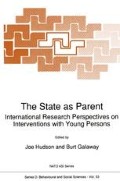Abstract
The overwhelming majority of children boarded out with foster parents are still at the younger end of the age range, but many public and voluntary agencies have established special placement projects to find families for adolescents, teenagers or other traditional “hard to place” groups. Anxiety of placements which “fail” is no less prevalent among this older group as the effects of disruption are perhaps more strongly felt. This paper is an empirical investigation into the factors which cause placements to fail in one such special fostering scheme: the Kent Family Placement Scheme (KFPS). Using routine monitoring procedures we explore the factors which are associated with, and predictive of, placement breakdown. A further aim has been to comment on the research methodology commonly used in previous breakdown research, which has rarely taken full advantage of the data collected. A description of the KFPS and a brief discussion of alternate measures of outcomes and definitions of breakdown are followed by an exposition of logit analysis — the methodology employed in this study. The results of these analyses — in which we successfully predict 79 per cent of placement outcomes — are reported under three heads: teenager characteristics, foster placement characteristics and child care practices. Implications for care practice are highlighted.
Access this chapter
Tax calculation will be finalised at checkout
Purchases are for personal use only
Preview
Unable to display preview. Download preview PDF.
References
Aldgate, J. & Hawley, D. (1986). Preventing disruption in long-term foster care. Adoption and Fostering, 10(3), 23–30.
Berridge, D. & Cleaver, H. (1987). Foster home breakdown. Oxford: Basil Blackwell.
Boyd, L.H. & Remy, L.L. (1978). Is foster parent training worthwhile? Social Service Review, 52, 275–296.
Cautley, P.W. (1980). New foster parents. New York: Human Services.
Department of Health and Social Security (1976). Foster Care. London: HMSO.
Devon County Council (1981). Study of fostering terminations, Mimeograph, Devon C.C.
Donley, K. (1978). The dynamics of disruption. Adoption and Fostering, 2(2)., 34–39.
Fanshell, D. & Shinn, E.B. (1978). Children in foster care. New York: Columbia University Press.
Hazel, N. (1981). A bridge to independence. Oxford: Basil Blackwell.
Millham, S., Bullock, R., Hosie, K., & Haak, M. (1986). Lost in care. Aldershot: Gower.
Olsen, L.J. (1982). Predicting the permanency status of children in foster care. Social Work Research and Abstracts, 18 (1), 9–20.
Pardeck, J.T. (1982). The forgotten children. Washington DC: University Press of America.
Parker, R.A. (1966). Decision in child care. London: Allen and Unwin.
Parker, R.A. (1983). A forward look at the research and the child in care mimeograph, University of Bristol.
Parker, R.A. (1988). Residential care for children. In I. Sinclair (Ed.) Residential Care: The Research Reviewed. Volume 2: Wagner Committee Report. London: HMSO.
Proch, K. & Taber, M.A. (1985). Placement disruption: a review of research. Children and Youth Services Review, 7, 309–320.
Rosenthal, J.A. Schmidt, D. & Conner, J. (1988). Predictors of special needs adoption disruption: An exploratory study. Children and Youth Services Review, 10(2), 101–117.
Rowe, J. (1987). Fostering outcomes: Interpreting breakdown rates. Adoption and Fostering, 11(1), 32–34.
Rowe, J., Cain, H., Hundleby, M. & Keane, A. (1984). Long-term foster care. London: Batsford.
Shaw, M. & Hipgrave, T. (1983). Specialist fostering. London: Batsford.
Thoburn, J. (1989). The effectiveness of permanent substitute family placement for older children in care. Paper prepared for NATO ARW, Maratea.
Walsh, J.A. & Matule, V.P. (1984). A formal statistical model for the prediction of stability of placement of foster children in the Casey Family Program. Unpublished paper cited in Prosch and Taber (1985).
Editor information
Editors and Affiliations
Rights and permissions
Copyright information
© 1989 Kluwer Academic Publishers
About this chapter
Cite this chapter
Fenyo, A., Knapp, M., Baines, B. (1989). Foster Care Breakdown: A Study of a Special Teenager Fostering Scheme. In: Hudson, J., Galaway, B. (eds) The State as Parent. NATO ASI Series, vol 53. Springer, Dordrecht. https://doi.org/10.1007/978-94-009-1053-9_25
Download citation
DOI: https://doi.org/10.1007/978-94-009-1053-9_25
Publisher Name: Springer, Dordrecht
Print ISBN: 978-94-010-6965-6
Online ISBN: 978-94-009-1053-9
eBook Packages: Springer Book Archive

